Ultrafast & Terahertz Photonics Group
|
Ultrafast optical techniques provide powerful probes of different states of matter, using light pulses that have femtosecond duration. In Warwick our activities span a number of areas:
|
Group facilitiesThe Group has labs across the campus, in the main Physics building, Materials and Analytical Sciences, and Millburn House. Read more about our experimental capabilities in terahertz science and technology. We also run the Warwick Centre for Ultrafast Spectroscopy Research Technology Platform. 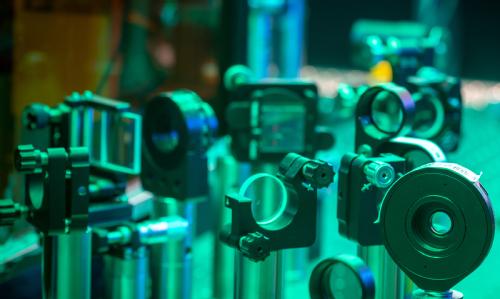
We make use of a wide range of Warwick's excellent materials analysis equipment, including X-ray diffraction, Raman spectroscopy, electron microscopy and magnetometry. |
Join the group!Please get in touch if you are interested in a PhD or MSc by Research in the group. We have two funded PhD projects available for 2024 start: with Dr Adam Wright on polaritons in perovskite solar cell materialsLink opens in a new window, and Prof. Emma MacPherson on THz robotic probes of skin cancerLink opens in a new window. 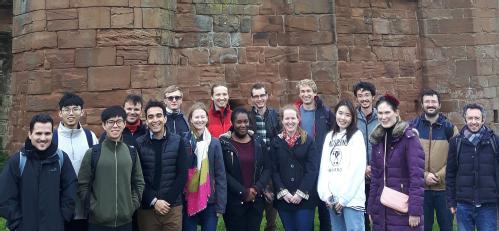
Group, Theses & PhotosContact details for our current group members and our photo gallery. For recent theses from the group, please see here. |
Research areas
Nanomaterials
We use pump/probe spectroscopy to study how light and matter interact on femtosecond to nanosecond timescales. Using visible probes we can track electronic processes, while infrared radiation lets us study vibrational states of molecules and atomic-scale defects in semiconductors.
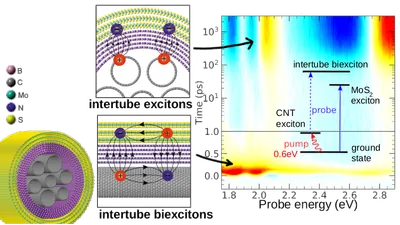
Recent papers:
The 3237 cm−1 diamond defect: Ultrafast vibrational dynamics, concentration calibration, and relationship to the N3VH0 defect
High-bandwidth perovskite photonic sources on silicon
Terahertz medical imaging
Performing in vivo studies of the THz properties of skin is a major initiative in the group, supported by the EPSRC Terabotics Programme GrantLink opens in a new window. We develop robust measurement protocols and test them on a statistically significant number of patients, cross-checking with other methods.
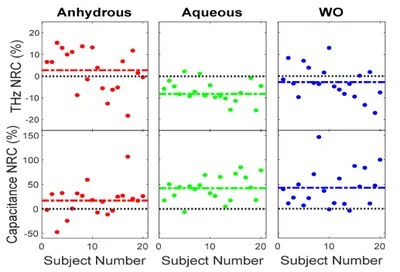
Recent papers:
Terahertz probe for real time in vivo skin hydration evaluation
Spectroscopic insight on impact of environment on natural photoprotectants
The 2023 terahertz science and technology roadmap
Semiconductors and Energy materials
A major strand of our research is to improve our knowledge of the fundamental science underpinning new semiconductor materials, such as metal-halide perovskites, which are often attractive for photovoltaic applications.
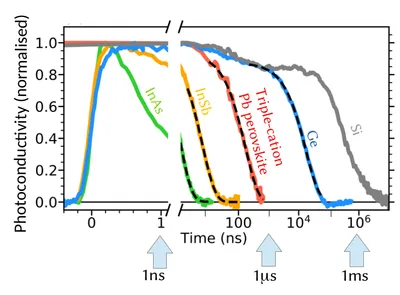
Recent papers:
Terahertz Emission via Optical Rectification in a Metal-Free Perovskite Crystal
High-bandwidth perovskite photonic sources on silicon
Resolving the Ultrafast Charge Carrier Dynamics of 2D and 3D Domains within a Mixed 2D/3D Lead-Tin Perovskite
Terahertz components, methods and techniques
We develop new THz devices and integrate them into novel systems designs that can perform THz imaging and THz spectroscopy faster, and with increased capabilities (e.g. polarisation control; robot-controlled probes).
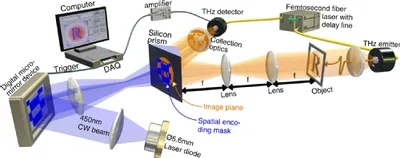
Recent papers:
Simultaneous measurement of orthogonal terahertz fields via an emission multiplexing scheme
Optimum Optical Designs for Diffraction-Limited Terahertz Spectroscopy and Imaging Systems Using Off-Axis Parabolic Mirrors
The 2023 terahertz science and technology roadmap
Recent publication highlights [filter by topic: view all | highlights | THz | perovskites | nano | biomedical]
Scalable interdigitated photoconductive emitters for the electrical modulation of terahertz beams with arbitrary linear polarization
C.D.W. Mosley, M. Staniforth, A. I. Hernandez Serrano, E. Pickwell-MacPherson and J. Lloyd-Hughes
AIP Advances 9, 045323 (Apr 2019) [ pdf ] [ ref ]
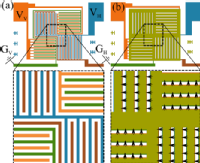 A multi-element interdigitated photoconductive emitter for broadband THz polarization rotation is proposed and experimentally verified. The device consists of separate pixels for the emission of horizontally and vertically polarized THz radiation. The broadband (0.3–5.0 THz) nature of the device is demonstrated, and the polarization angle of the generated far-field THz radiation is shown to be readily controlled by varying the relative bias voltage applied to the horizontally and vertically emitting pixels. The device is scalable in design, and with its simple method of polarization rotation it allows the modulation of the generated THz polarization at rates significantly faster than those achievable in ellipsometry systems based on mechanically rotating components.
A multi-element interdigitated photoconductive emitter for broadband THz polarization rotation is proposed and experimentally verified. The device consists of separate pixels for the emission of horizontally and vertically polarized THz radiation. The broadband (0.3–5.0 THz) nature of the device is demonstrated, and the polarization angle of the generated far-field THz radiation is shown to be readily controlled by varying the relative bias voltage applied to the horizontally and vertically emitting pixels. The device is scalable in design, and with its simple method of polarization rotation it allows the modulation of the generated THz polarization at rates significantly faster than those achievable in ellipsometry systems based on mechanically rotating components.
Utilizing multilayer structures to enhance terahertz characterization of thin films ranging from aqueous solutions to histology slides
Q. Sun, K. Liu, X. Chen, X. Liu, A. I Hernandez-Serrano, E. Pickwell-MacPherson
Optics Letters 44 2149 (April 2019) [ pdf ] [ ref ]
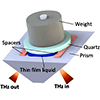 We propose a multilayer geometry to characterize thin-film samples in reflection terahertz time domain spectroscopy. Theory indicates that this geometry has higher sensitivity compared to ordinary transmission or reflection geometries when characterizing both low- and high-absorption samples. Pure water and water–ethanol mixtures are measured to verify the characterization accuracy of the proposed geometry and its capability to measure trace liquids. Paraffin-embedded oral cancer tissue is imaged to further show how the proposed geometry enhances the sensitivity for solid low-absorptive films.
We propose a multilayer geometry to characterize thin-film samples in reflection terahertz time domain spectroscopy. Theory indicates that this geometry has higher sensitivity compared to ordinary transmission or reflection geometries when characterizing both low- and high-absorption samples. Pure water and water–ethanol mixtures are measured to verify the characterization accuracy of the proposed geometry and its capability to measure trace liquids. Paraffin-embedded oral cancer tissue is imaged to further show how the proposed geometry enhances the sensitivity for solid low-absorptive films.
Design and fabrication of 3-D printed conductive polymer structures for THz polarization control
A.I. Hernandez-Serrano, Q. Sun, E.G. Bishop, E.R. Griffiths, C.P. Purssel, S.J. Leigh, J. Lloyd-Hughes and E. Pickwell-MacPherson
Optics Express 27 8 11635 (April 2019) [ pdf ] [ ref ]
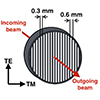
In this paper, we numerically and experimentally demonstrate the inverse polarization effect in three-dimensional (3-D) printed polarizers for the frequency range of 0.5 - 2.7 THz. The polarizers simply consist of 3-D printed strip lines of conductive polylactic acid (CPLA, Proto-Pasta) and do not require a substrate or any further metallic deposition. The experimental and numerical results show that the proposed structure acts as a broadband polarizer between the range of 0.3 THz to 2.7 THz, in which the inverse polarization effect is clearly seen for frequencies above 0.5 THz. In the inverse polarization effect, the transmission of the transverse electric (TE) component exceeds that of the TM component, in contrast to the behavior of a typical wire-grid polarizer. We show how the performance of the polarizers depends on the spacing and thickness of the CPLA structure; extinction ratios higher than 20 dB are achieved. This is the first report using CPLA to fabricate THz polarizers, demonstrating the potential of using conductive polymers to design THz components efficiently and robustly.
Giant negative terahertz photoconductivity in controllably doped carbon nanotube networks
M.G. Burdanova, A.P. Tsapenko, D.A. Satco, R.J. Kashtiban, C.D.W. Mosley, M. Monti, M. Staniforth, J. Sloan, Y. Gladush, A.G. Nasibulin and J. Lloyd-Hughes
ACS Photonics 6 1058 (Mar 2019) [ preprint pdf ] [ supplemental info ] [ ref ]
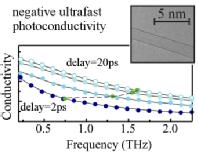 A strong negative photoconductivity was identified in thin film networks of single-walled carbon nanotubes using optical pump, THz probe spectroscopy. The films were controllably doped, using either adsorption doping with different p-type dopant concentrations, or ambipolar doping using an ionic gate. While doping enhanced the THz conductivity and increased the momentum scattering rate, interband photoexcitation lowered the spectral weight and reduced the momentum scattering rate. This negative THz photoconductivity was observed for all doping levels, regardless of the chemical potential, and decayed within a few picoseconds. The strong many-body interactions inherent to these 1D conductors led to trion formation under photoexcitation, lowering the overall conductivity of the carbon nanotube network. The large amplitude of negative THz photoconductivity and the tunability of its recovery time with doping offer promise for spectrally wide-band ultrafast devices including THz detectors, polarizers and modulators.
A strong negative photoconductivity was identified in thin film networks of single-walled carbon nanotubes using optical pump, THz probe spectroscopy. The films were controllably doped, using either adsorption doping with different p-type dopant concentrations, or ambipolar doping using an ionic gate. While doping enhanced the THz conductivity and increased the momentum scattering rate, interband photoexcitation lowered the spectral weight and reduced the momentum scattering rate. This negative THz photoconductivity was observed for all doping levels, regardless of the chemical potential, and decayed within a few picoseconds. The strong many-body interactions inherent to these 1D conductors led to trion formation under photoexcitation, lowering the overall conductivity of the carbon nanotube network. The large amplitude of negative THz photoconductivity and the tunability of its recovery time with doping offer promise for spectrally wide-band ultrafast devices including THz detectors, polarizers and modulators.

